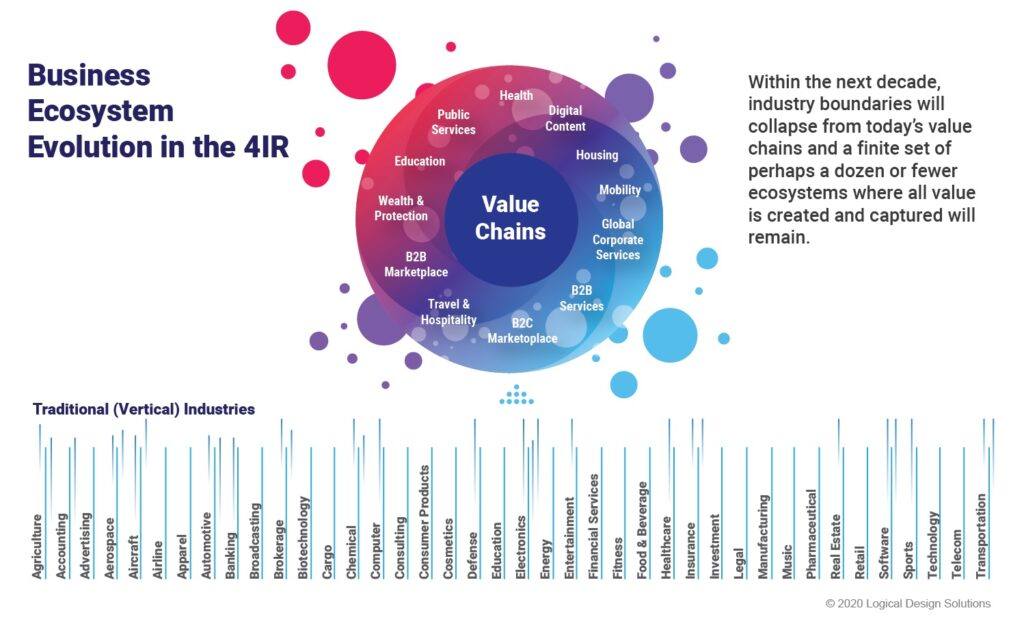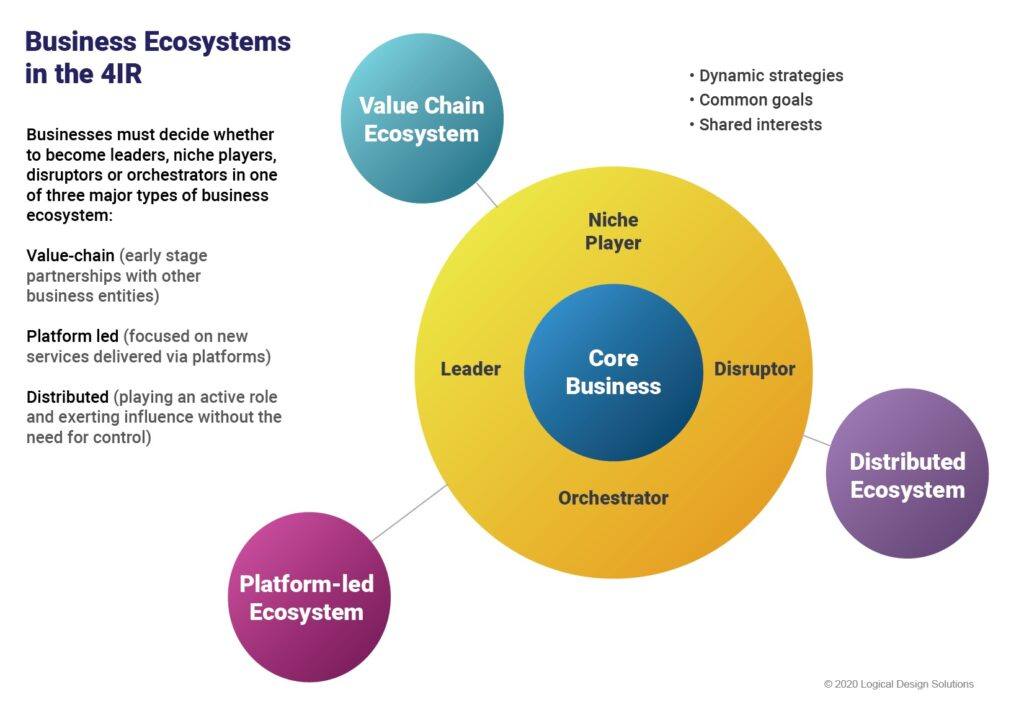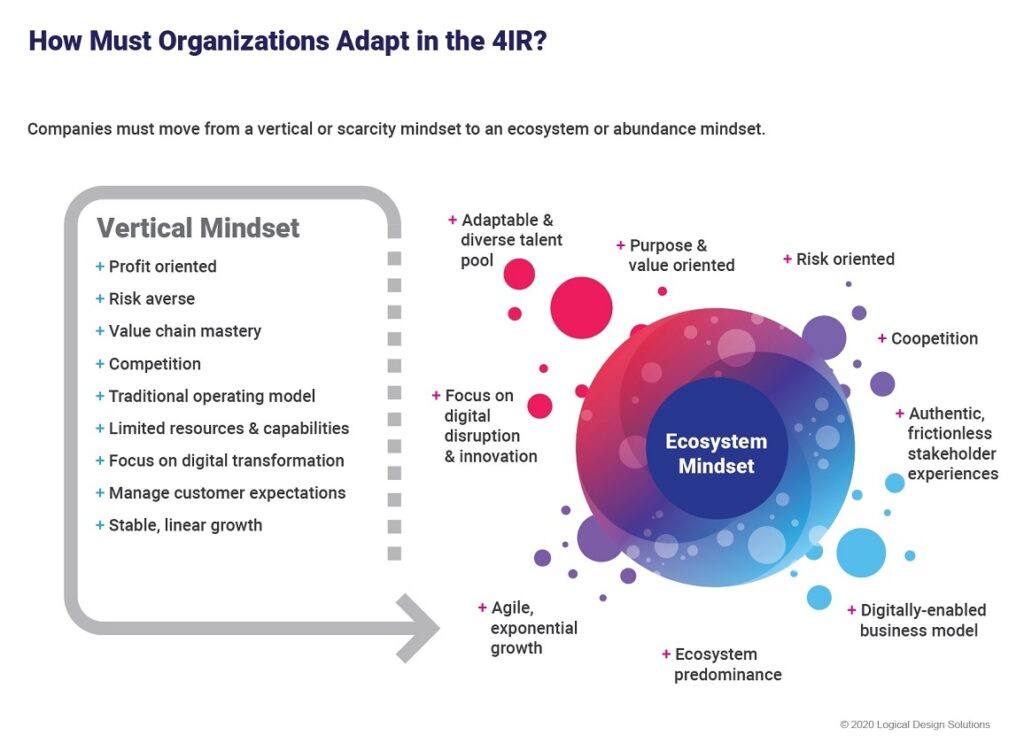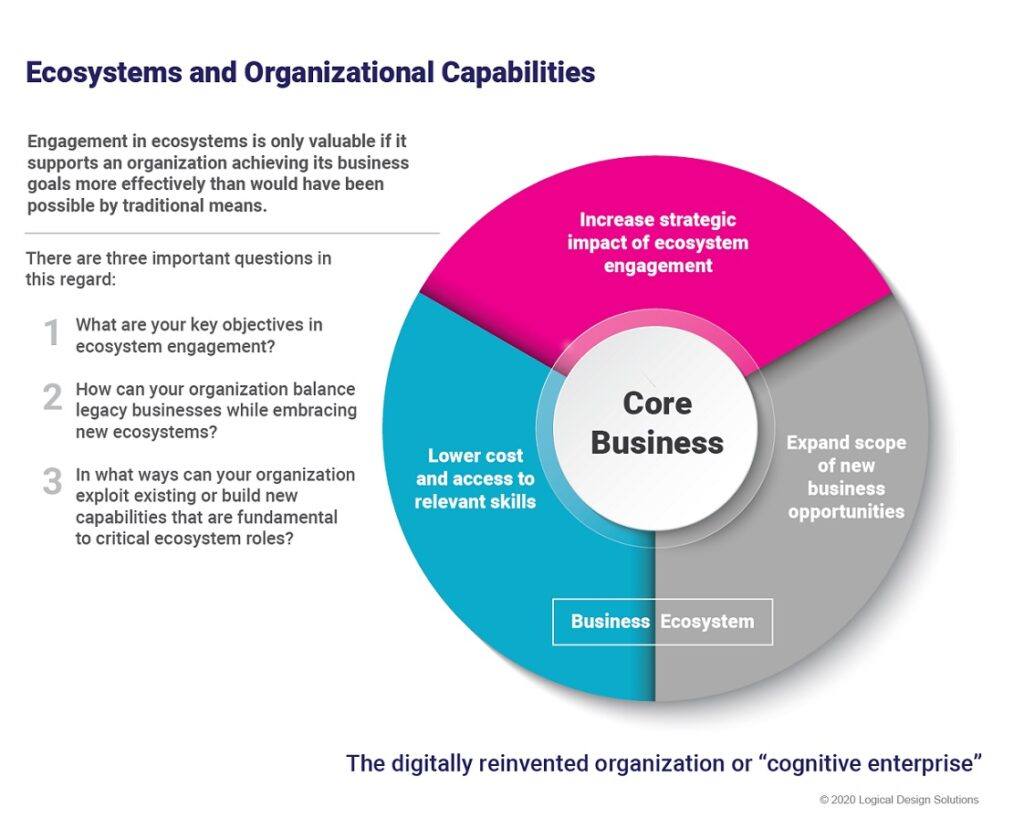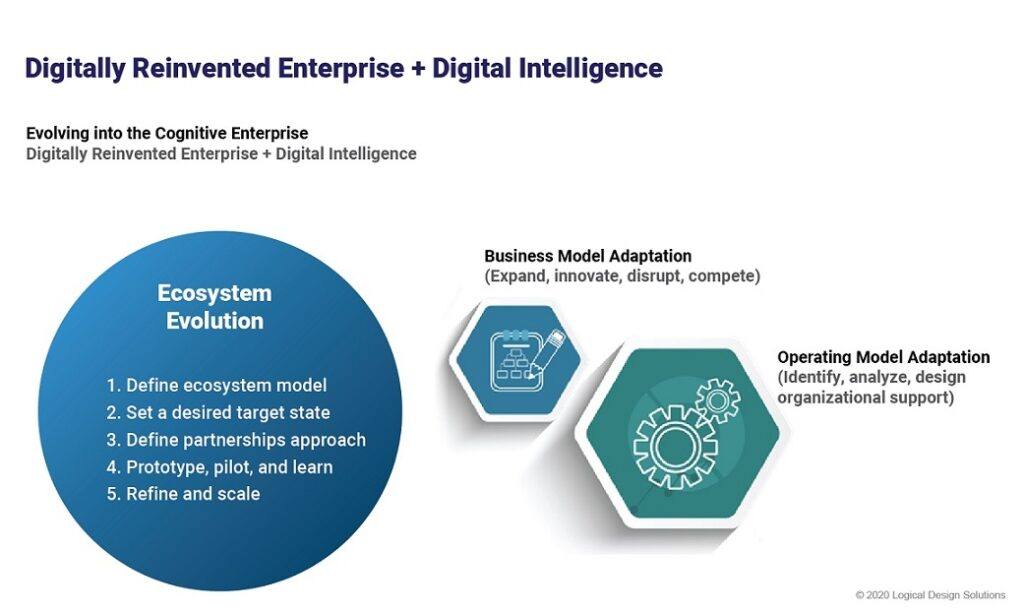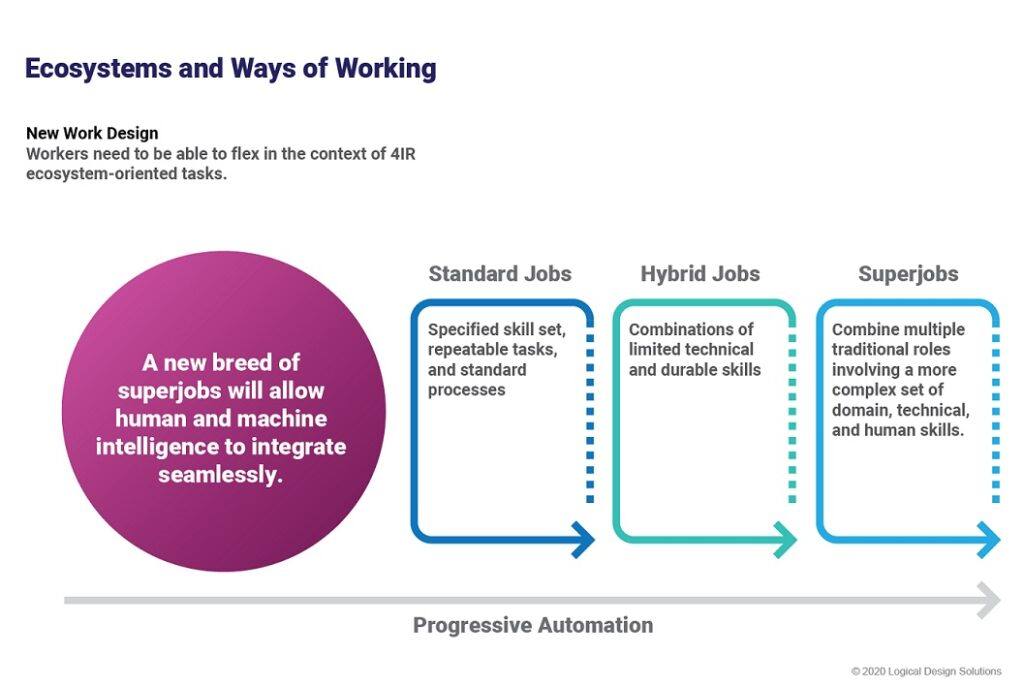The world is no longer speaks industries, but EcoSystems

Traditional industry boundaries are being dramatically reshaped by digitization as the second wave of the Fourth Industrial Revolution (4IR) sweeps across the world of commerce. We are already seeing the emergence of massive business ecosystems that are consuming vertically-aligned markets and creating multi-industry solutions driven by rapidly emerging technologies like artificial intelligence, machine learning, robotics, blockchain and other cognitive systems. No entity is immune to these changes and business leaders across the globe are rethinking their strategic approaches as they face the unstoppable momentum of the 4IR.
Historically, the word “ecosystem” was coined in the 1930s by British botanist Arthur Tansley. He was describing a localized community of living organisms interacting with each other and their environment of air, water, mineral soil, and other elements. According to Tansley, these organisms were influencing each other and their terrain by competing and collaborating, sharing and creating resources, and co-evolving. He also pointed out that these ecosystems are always subject to external disruptions, to which they respond by adapting together as necessary.
Similarly, a business ecosystem can be described as “a complex network of interconnected businesses that depend on and feed on each other to deliver value for their customers, to the end users, and their key stakeholders.”
Along the same lines, a “platform” is a powerful type of ecosystem, usually created and owned by a single business or entity, but specifically designed to attract the active participation of large numbers of other interested parties. According to scholar Yochai Benkler, it is “a technical and organizational context in which a community can interact to achieve a specific purpose.”
To put it in plain terms:
- A business ecosystem may be described as a sphere of industry sectors that have no borders.
- Value creation within an ecosystem will result from horizontally aligned players cooperating across industry boundaries in order to harness rewards from that value.
- Entire networks of stakeholders, including business partners, suppliers, customers, and even competitors, will interact digitally to supersede traditional industry boundaries.
- Evolving ecosystems will be primarily driven by the basic needs of individuals or organizations.
- Recent studies suggest that traditional vertical industries will be largely replaced by a dozen business ecosystems by 2025. These enormous value chains might look something like this:
Figure 1 – Predicted business ecosystem evolution
Although they have existed in some form or other since humans first engaged in commerce, the rise of massive global business ecosystems is unprecedented and is being driven primarily by the evolution of digital technologies and rising consumer demands:
- Technology is now enabling a player in one sector to go and capture value beyond their own sector.
- The disruptive effect that digital technology and data availability coupled with advanced analytics is having on traditional industry boundaries is unprecedented.
- Consumer expectations have evolved to a point where customers are expecting companies to understand what their broader needs are and service those needs proactively.
As shown in this diagram, once vertical industries become immersed in ecosystems, companies must make strategic choices whether to become leaders, orchestrators, disruptors, or niche players in a particular sphere. A secondary but no less important decision is whether to become a part of a value chain, platform-led, or distributed ecosystem. These decisions are premised around the existence of dynamic strategies, common goals, and shared interests with other players.
Figure 2 – Strategic Approaches to Business Ecosystem Evolution
Secondly, the gathering pace of the 4IR dictates that companies must move away from risk aversion to embracing risk as an integral part of everyday business. Failure to do so in today’s market invites disruption. As Disney CEO Bob Iger has said, “The riskiest thing we can do is maintain the status quo.”
Thirdly, when your product is delivered digitally, it is of course essential to move from mastery of your value chain to becoming a mastermind and orchestrator of your ecosystem. In other words, being in control of the data at the first customer touchpoint. Some would say that this is analogous to a country that controls the flow of water from a river that others rely on downstream. While everyone can still benefit from the flow of water, the primary source holds the power.
Next is the transition from competition to coopetition, whereby everyone benefits from collaboration and there is opportunity for all. In the rapidly evolving ecosystem environment, there is far greater interdependence and enablement between companies than ever before. We are seeing a shift away from traditional operating models to digitally-enabled business models that can function ever more efficiently in the ecosystem environment.
The rise of the gig worker has also resulted in a shift away from the limited resources and capabilities of corporate monoliths to a much more abundant and diversified ecosystem-oriented talent pool that is capable of leveraging the durable skills that are becoming so critical for survival in a world where automation through artificial intelligence and machine learning is prevalent.
Companies with an ecosystem mindset have also moved beyond the notion of digital transformation to an environment that is focused on digital disruption and innovation. They have gone beyond simply managing customer expectations to striving for authentic, frictionless stakeholder experiences. In effect, companies with an ecosystem mindset are not seeking stable, linear growth patterns, but rather are adopting agile practices with a view to exponential growth.
Figure 3 – Organizational Adaptation in the 4IR
Ecosystems are forcing 4IR businesses to think and act very differently regarding not only strategic approaches but also business models, leadership, core capabilities, value creation and capture systems, and organizational models. Ultimately, the key to success in this fast-changing environment is to transform businesses and organizations without destroying them.
During a time of rapid convergence of enabling technologies, customer desires, and business ecosystems, rethinking the fundamentals of how a business creates and captures value is an absolute priority. We are approaching a juncture in the 4IR that invokes Darwin’s theory of the survival of the fittest. As such, companies must now seek to innovate at the level of their business models. This can be achieved through what some are referring to as minimum viable transformation. This means pulling together the essential elements of new business models into barely working prototype models specifically designed to test key risks before establishing the company’s role as a leader, disruptor, orchestrator, or niche player in an ecosystem.
Minimum viable transformation means relooking at operations, product development, management systems, supply chain, and cost structures, then reviewing customer engagement, service, channels, distribution, and revenue streams in order to understand the overall profit model inherent in evolving an organic ecosystem or becoming part of a deliberate ecosystem.
It is nothing new that business model transformations must consider the evolution of a company’s broader ecosystem. However, what is new in the 4IR is that such transformations must be considered and accomplished routinely — not as one-off events.
Figure 4 – Ecosystems and Organizational Capabilities
Do ecosystem-oriented companies have an enduring advantage? In all likelihood, given the accelerating pace of the 4IR, the answer is yes. From a strategic point of view, perhaps a good analogy is that while traditional companies are building moats to protect the business from competitors, ecosystem companies are operating turnstiles. In other words, while vertical institutions have enjoyed success over the past 40 years by protecting a combination of high entry barriers and product differentiators or by investing in assets that are hard to find, ecosystem companies have adopted a strategy that seeks to link rather than exclude companies and their assets. These are what may be referred to as “cognitive enterprises.”
A cognitive enterprise is an organization that creates knowledge and data to expand virtually everyone’s expertise, continually learning and adapting to outthink the needs of the market while augmenting human intelligence
The goal of a cognitive enterprise is to help your organization establish its place in its broader ecosystem to include not only suppliers and customers, but also your consumers’ influencers as well as groups in adjacent businesses.
The five stages of evolving into a cognitive enterprise are as follows:
- Define the ecosystem model in terms of core functions, ecosystem functions, extended services, and customer and ecosystem value.
- Clarify the vision for the new ecosystem model by conducting an impact analysis, determining the optimal role for the company, envisioning an ecosystem blueprint, and then settling on an acceptable target state.
- Determine an approach towards the identification, engagement, and government of prospective partners.
- Produce a pilot that tests the viability of the new model and then build innovative capabilities via iterative testing and continuous optimization.
- Embrace the learning from any pilots conducted to date and then define the plan for the next phase.
Of course, new organizational growth maps are needed and traditional jobs need to shift to the nature of new work practices as business ecosystems evolve with new digital capabilities. After all, the traits of a successful digital transformation are increased agility, innovation, and levels of collaboration that become deeply embedded in the culture of the organization. Worker adoption and mastery are the keys to the ultimate success of any cognitive enterprise.
Figure 5 – Evolving into the Cognitive Enterprise
So how does the evolution of ecosystems relate to ways of working? As many corporate leaders have recognized, the smartest people can’t all work for just one organization. This means, importantly, that they don’t all work for yours. Ecosystems provide businesses access to intelligent minds and smart resources, whether these are found within suppliers, customers, research organizations, or independent resources.
We need to continuously learn and adapt in order to find our place in the evolving ecosystems around us. As Alvin Toffler once said, “The illiterate of the 21st century will not be those that can’t read or write, but those who cannot learn, unlearn, and relearn.” The 4IR is enabling human work to be reframed in terms of problem-solving and the ability to create new knowledge.
Once an organization’s capability to create value in a digital world is understood, it is critical to focus on nurturing a workforce that possesses the ability to adapt quickly, is comfortable with change, is not afraid to take risks, is highly collaborative, and consists of critical, systems-based thinkers. We need to focus on ways of working in that context. Management must light the way by becoming talent champions who focus on the capabilities that are needed in the future state as well as encouraging and rewarding aligned behaviors.
Business leaders must adopt a strategy that considers the new environment in which business goals must be achieved. This is achieved by embracing uncertainty and comprehending 4IR-driven technologies. The creation of what will become known as superjobs and the expansion of new tasks as part of their creation will necessitate organizations thinking about work design in new and profound ways.
Importantly, if jobs and work are reconfigured to combine the strengths of the human workforce with machines and platforms, the optimal result will be major improvements in not only customer service, but also output and productivity. The trick will be to arrange the work so that it can ensure the success of humans and machines operating cohesively in evolving work environments while at the same time leveraging the uniquely human traits of imagination, empathy, and curiosity.
Figure 6 – Ecosystems and New Ways of Working
The first wave of the 4IR escalated culture and engagement into the realm of everyday business. We soon learned the critical fact that new work practices must be instantiated as culture.
New work design in the 4IR will mean that the jobs of the future are focused more on multidisciplinary, digitally-driven tasks. These super jobs will combine traditional functions with roles that take full advantage of the significant productivity and efficiency gains that occur when people work with technology.
The first wave of the 4IR escalated culture and engagement into the realm of everyday business. We soon learned the critical fact that new work practices must be instantiated as culture.
As many companies have discovered to their cost, pervasive digital reach means that every cultural nuance within a company is fair game for public consumption and discussion. Pursuing a diversity of ideas, encouraging participation through shared learnings, embedding customer-centric ideals, and informal ways of working must in turn enable reliable, impromptu action and insights when these are needed most.
Employees will remain the crucial glue in the future of work as they assume ever more complex tasks, leaving repetitive, everyday chores to machines. In an environment that opens new avenues of intellectual challenge and productivity for core workers, along with a more flexible and agile way of conducting everyday business, it is critical that those individuals are fully engaged and recognized for their elevated level of contribution to the enterprise.
